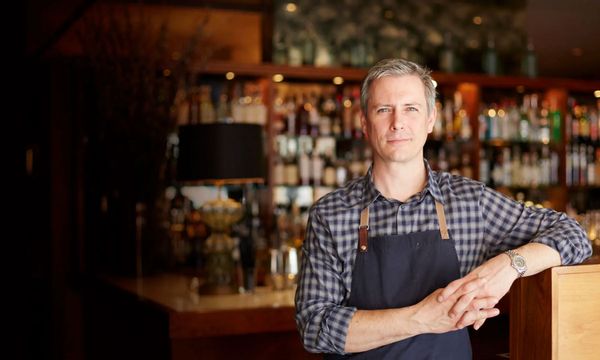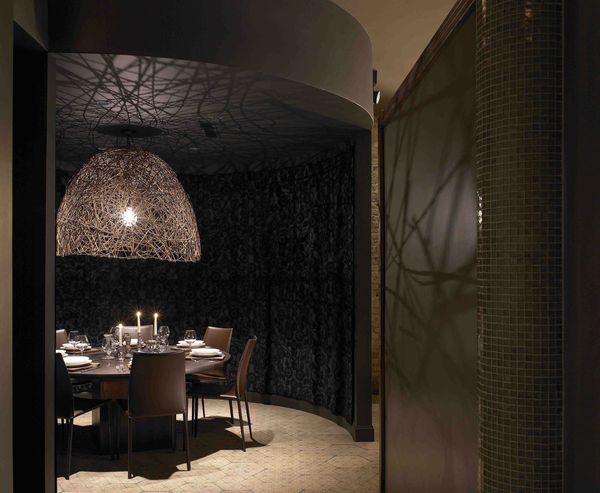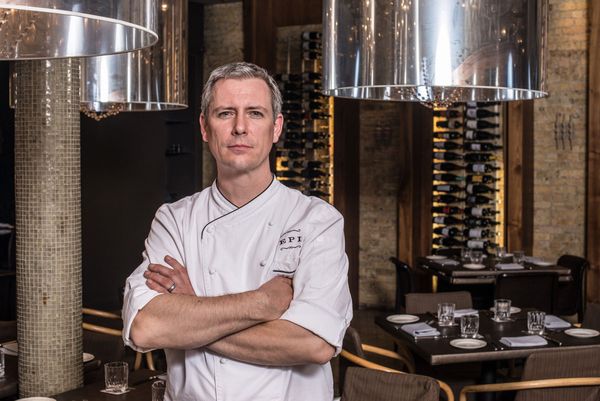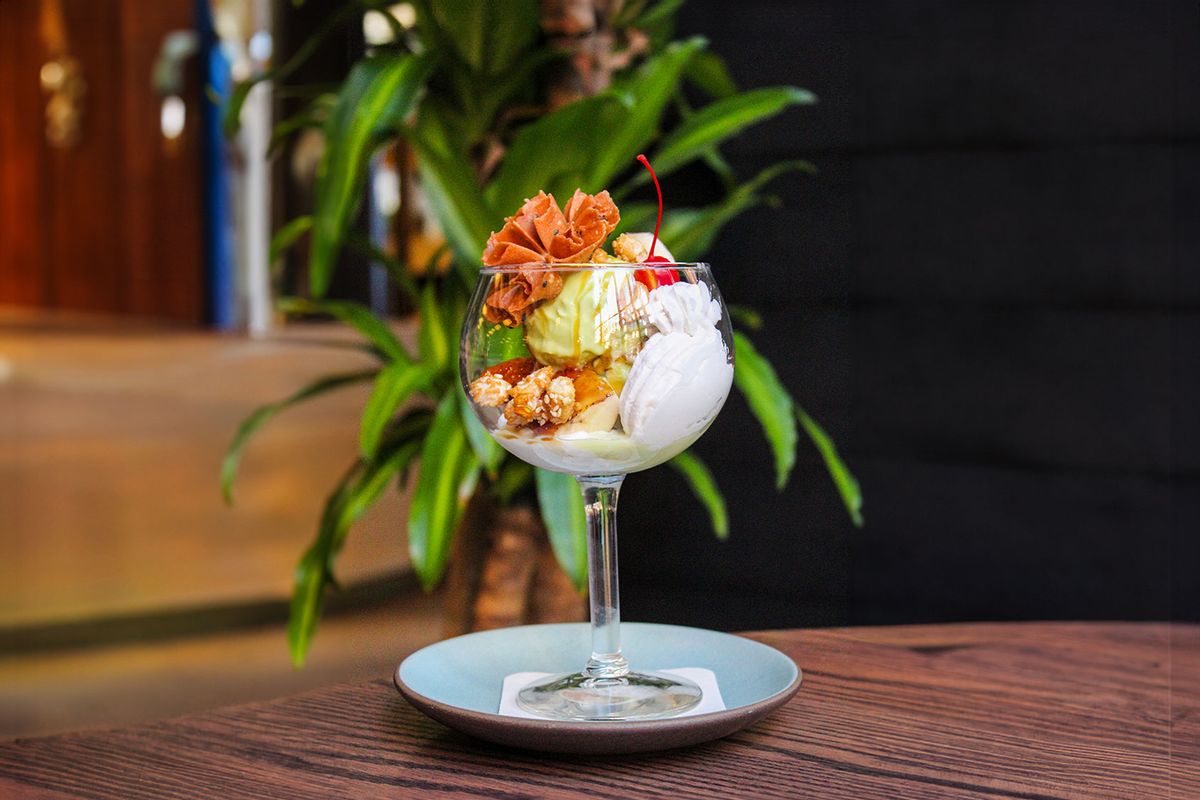For any chef, winning a Michelin star is an accolade unlike any other. Retaining said stars, though, is a whole other story.
So for Chef Andrew Zimmerman of Chicago's Sepia, who's retained the restaurant's stars under his leadership for 13 years, that level of perfection, persistence, grit and talent is almost unheard of.
Zimmerman, who also recently opened another restaurant named Proxi, originally came to Sepia in 2009 and the restaurant won its first star under his tutelage two years later, in 2011. Since then, Sepia has been a darling of the restaurant world, not only in its native Chicago, but nationwide. As the Michelin page itself says, "Chef Andrew Zimmerman’s menu is a delicious amalgam of American cuisine with hints of Southeast Asian, Korean, and Mediterranean tastes."
Salon Food had the pleasure of speaking with Zimmerman about his time at Sepia, his inspirations at Proxi, the role of music in his life, standout dishes, why he cooks and more.
The following interview has been lightly edited for clarity and length.
 Chef Andrew Zimmerman (Photo courtesy of David Turner)
Chef Andrew Zimmerman (Photo courtesy of David Turner)
You've led Sepia since 2009 and it's held onto its Michelin star since 2011 — that's incredible! What do you attribute that sort of stunning success to? And how does it propel you towards your next milestone
Any success that we’ve had all comes down to building and developing a strong team, both in the kitchen and in the Front of House. In the time I have been the Chef at Sepia, I have been fortunate to work with some very talented and driven people who helped set and uphold the kind of standards needed to be in the conversation for a star.
The star itself, I think has helped us continue to push and evolve as no one wants to be part of the team that failed to retain it for the next year. Hopefully our desire to do good work, feed people delicious, exciting food and make them feel welcome and well cared for will propel us on to our twentieth anniversary and beyond.
The website says "Built from an 1890 print shop, Sepia features memorabilia from the Windy City’s bygone eras." I'd love to hear more about that?
The building did, in fact, house a photo studio and print shop back around the turn of the twentieth century and my business partner and founder of the restaurant Emmanuel Nony used that as inspiration for the vibe and décor. We have several pieces of art around the dining room that were created using vintage photos from that era as well as a large, antique accordion style camera by the entry way. The bar and host stand in particular also have a very vintage feel being crafted out of wood and marble with vintage accents. Emmanuel wanted to create a feeling of timeless vintage glamor in the space.
 Sepia interior (Photo courtesy of Sepia)
Sepia interior (Photo courtesy of Sepia)
The website also notes "Sepia celebrates tradition — with a modern twist." Could you speak a bit to that?
When we talk about the “celebrating tradition” we mean using classic cooking methods . . . also known as “doing it the hard way” as the starting point of our cuisine. We make just about everything you are going to eat from the cultured house made butter to the hand stuffed pasta, [etcetera].
As for a modern twist, that speaks to our willingness to play with the flavors and presentations and use those traditional methods and attitudes to produce food that is contemporary and creative.
I'm a big music guy, so I'd love to know a bit about how you think your music background plays into your role and growth as a chef? Or, conversely, what are your favorite albums/artists to listen to in the kitchen at home?
I have always had very eclectic tastes in music. I think that my openness and curiosity around music helped set the stage for my openness and curiosity with food too. Music is probably also where I was first introduced to the idea that an artist could try out or mix different styles, often in the same song. That shows up in our cooking anytime we play with how we want to present flavors.
For example, if we do a dish of ‘Toasted Masa Cavatelli with Chestnut Mushrooms, Roasted Poblano Cream and Cotija Cheese”, that dish presents like a very Italian dish, but is all Mexican flavors.
Want more great food writing and recipes? Subscribe to Salon Food's newsletter, The Bite.
Sepia and Proxi aren't anything like one another and both totally unique unto themselves. How do you differentiate between the two?
Sepia and PROXI are different in appearance and in style, that is true. PROXI is less formal than Sepia, it’s bigger and louder and has a different energy for sure. I think of the food at PROXI as being more immediate and direct, with big bold flavors, an emphasis on cooking over a live fire. Sepia on the other hand is admittedly more refined, more delicate and less brash. The vibe may be different but both restaurants draw on my enthusiasm for flavors from around the world. In many ways, I think the biggest difference is just in how we are choosing to present those flavors.
Is there a particular dish from either restaurant that you think best typifies your current culinary approach and ethos?
At Sepia I think the “Kanpachi Crudo with Tikka Masala Consommé, Avocado and Almond” is a great example. It takes a very familiar format (raw fish and avocado) but introduces flavors (Chicken Tikka Masala) that aren’t immediately associated with that format. Usually, you’d fall into either Japanese or Mexican flavors when approaching raw fish and avocado.
Similarly, at PROXI a dish like “Green Curry Ice Cream Sunday with Candied Peanuts, Bruleed Banana, Whipped Coconut Cream and Fish Sauce Caramel” takes a very familiar idea and presents it in a new refreshing way.
I'm fascinated by the tikka masala consommé in the kanpachi crudo! How did the idea for that come about? Also love the sound of the malted rye ice cream and the pretzel puff pastry in the dark chocolate crema catalana
The tikka masala consommé was the brainchild of our incredible Chef de Cuisine Kyle Cottle. He knows of my affection for Indian food and wanted to do something creative with the idea of tomato water. He had the very clever idea to season the tomato water so it would suggest the flavors of the sauce for chicken tikka masala. The rest flowed from there.
The chocolate crema catalana was created by our equally fantastic pastry Chef Erin Kobler. Outside of some discussions on crema catalana techniques and presentations, you’d have to ask her. It is a very creative (and delicious) dish, how she came up with it is still something of a mystery to me. I mean — caramelized pretzel puff pastry?
 Proxi interior (Photo courtesy of Proxi)
Proxi interior (Photo courtesy of Proxi)
I'd love to hear a bit about all of the cultural influences that go into the menus at Proxi — the range is so interesting.
As a cook and a lover of food, I am interested in finding, trying and learning about things that are novel and delicious so that has led me to investigate all kinds of foods. I am drawn to big bold flavors like those of Southeast Asia, India and Mexico but my early culinary background was based in French and Italian cooking technique.
Some of the influences come from traveling to different countries, some from trying the food of other people here at home in Chicago and some from reading and cooking at home. I’m open to trying practically any food and seeing if it will have a place somewhere in the constantly evolving food that we create at Sepia and PROXI.
Why do you cook?
I cook because I love to make things, I love to eat tasty things and I love to do something that nourishes people and, hopefully, makes them happy.
What stands out for you as a formative moment that got you into cooking or food at large?
As a child of divorced parents, I would spend time with my father on weekends and summers. He was the one who introduced me to a more global palate, like sushi, Indian food and Thai food. The food I was eating back at home with my mother was a little more “traditional American” and I started to get a little bored with it. Then I realized that with the help of cookbooks I could teach myself to make nearly anything that sounded exciting and it all kind of took off from there.
We need your help to stay independent
What is your favorite cooking memory?
I have a lot of really important cooking memories, but surprising my future in-laws with risotto with lobster for dinner the first time I met them is a pretty good one. It worked out very well for me.
Do you have a number one favorite ingredient to cook with?
My honest answer to this question is gonna be a real boring one: love so many ingredients and flavors and they all have their place. The most important one though, has to be salt. It’s just the thing that makes everything else come to life. Just don’t overdo it.
How do you practice sustainability in your cooking?
We practice sustainability in our cooking by being mindful of how the products we are using were produced and by whom and, maybe even more importantly, by making efforts to use every last bit of those products to their fullest advantage. Things that might otherwise be considered scraps or trim find their way into sauces, sausages, pasta fillings, flavored powders, ferments and meals for the staff.
 Chef Andrew Zimmerman (Photo courtesy of David Turner)
Chef Andrew Zimmerman (Photo courtesy of David Turner)
What are some tips you'd give to home cooks for cutting down on food waste?
Some really good ways to cut down on food waste at home is to be open minded and flexible in your cooking. Look for recipes that are well suited to substitutions and variations. Fried rice for example (and stir frys in general) are a great way to take those last bits of a protein that maybe isn’t enough for a meal on its own and combine it with that half a carrot you saved in the crisper drawer and a couple other bits and bobs and make a tasty meal. Saucy Curries are also a great place to combine different vegetables and proteins and have it all be pulled together with a tasty sauce.
You've won an amazing amount of accolades thus far in your career — what's next for you?
At the moment what’s next for me is to continue to go to work every day and make the best food I can, share my knowledge with my staff and keep my mind and eyes open for exciting new foods and opportunities as they present themselves.



Shares